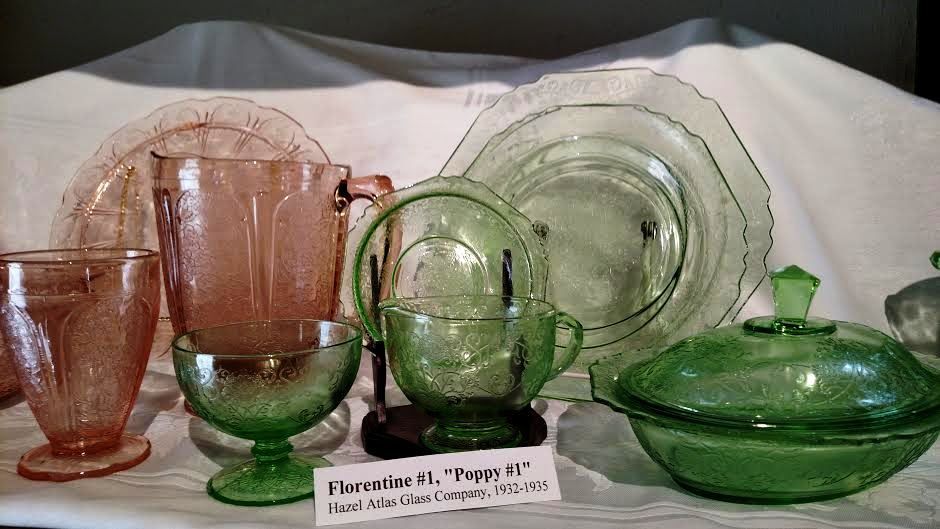By Jennifer Kohlhepp, Managing Editor
Candy-colored glassware sparkles on the shelves and dazzles in the display cases throughout the Arthur E. Perrine Memorial Wing of the Cranbury Museum.
The museum’s new exhibit features more than 300 pieces of Depression glass in shades of green, pink, yellow, blue, red, amber and white. Depression glass was produced to help color the lives of families suffering through the Great Depression. Molded by machine, the glassware was made cheaply and distributed free or at low cost throughout the United States and Canada.
“This is cheaply-made glass that came from cereal boxes or gas stations,” Jason Li, an assistant docent at the museum, said. “The glass was created in bright, vibrant colors and cheered up people living through the Depression, especially housewives who couldn’t afford to purchase what they used to. It is an important icon of the Depression Era.”
The Quaker Oats Company and other food manufacturers and distributors put pieces of the glassware in boxes of food or sacks of flour as purchase incentives. Movie theaters and businesses would also hand out pieces simply for coming in the door. The glass was also sold in dime stores such as Woolworth’s. Whole sets were offered as incentives to buy furniture.
Most of this glassware was made in the Ohio River Valley, where access to raw materials and power made manufacturing inexpensive in the first half of the 20th century. More than 20 manufacturers made more than 100 patterns, and entire dinner sets were made in some patterns. Common colors are clear (crystal), pink, pale blue, green, and amber. Less common colors include yellow (canary), ultramarine, jadeite (opaque pale green), delphite (opaque pale blue), cobalt blue, red (ruby and royal ruby), black, amethyst, monax, and white (milk glass).
On loan from the collection of Karen Kelley, the museum’s exhibit, “Depression Glass: Candy-Colored Glass of the Depression Era,” features nearly 100 patterns. An extensive collection of Mayfair Open Rose is displayed along with many other patterns, such as Adam, Cameo, Block Optic, Florentine, and Royal Lace. The left and right sides of the glass cases contain samples to help with identification of the patterns.
Vintage kitchenware, linens, and cutlery are also included in the exhibit, along with samples of Elegant Glassware. Elegant Glassware is finer, American made glassware that was sometimes acid etched and sold in department stores during the Depression Era through the early 1950s.
Although of marginal quality, Depression glass has been highly collectible since the 1960s. Due to its popularity as a collectible, Depression glass is becoming more scarce on the open market. Rare pieces may sell for several hundred dollars. Some manufacturers continued to make popular patterns after World War II, or introduced similar patterns, which are also collectible. Popular and expensive patterns and pieces have been reproduced, and reproductions are still being made.
The wing where the glassware is located was a gift to the museum from Mary E. Perrine. The wing was added in 1975 but the original two-room house at 4 Park Place East dates back to 1834. The house turned museum was built by Dr. Garret P. Voorhees. The Isaac Snedeker family added more rooms including the parlor, the second floor master bedroom and the Amy Evans Memorial Sewing Room between 1850 and 1862. The home’s last private owner, Marvin Dey, sold it to the Cranbury Historical and Preservation Society on March 30, 1972.
Countless artifacts tell stories of the past in the Cranbury Museum. Amid the 18th and 19th century furnishings are handmade items that speak volumes of long ago pastimes like lace making, tinsel painting and hair weaving. The basement area houses more memorabilia from early businesses and activities in town as well as permanent exhibits of farm implements, early tools, Lenape Indian artifacts, and artifacts recovered during the 1977 archaeological dig at Main Street and Park Place West.
The Cranbury Historical and Preservation Society operates the museum, which is open most Sundays from 1-4 p.m.

